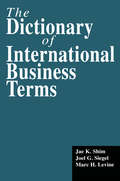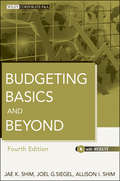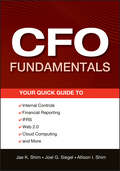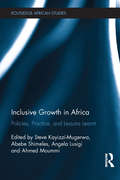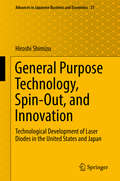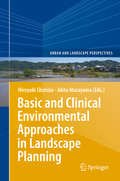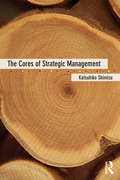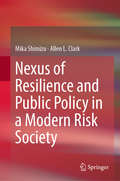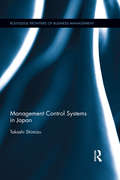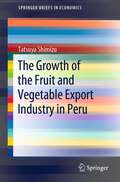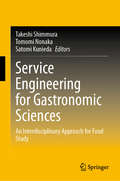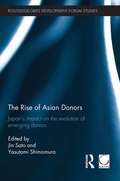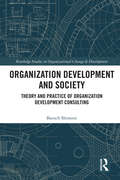- Table View
- List View
The Dictionary of International Business Terms (Glenlake Business Reference Bks.)
by Jae K. Shim Joel G. Siegel Marc H. LevineThe diversity and complexity associated with the increasing globalization and integration of economies require a familiarity with information technology and terminologies associated with international business. The Dictionary of International Business Terms will be valuable to students and professionals in all areas of business who need to keep abreast of this rapidly changing environment. Over 2,000 terms are defined with examples, charts and illustrations. Additional key areas covered include: global accounting and taxation; exports and imports; global trade, law, and regulations; international organizations; international finance, banking, and investments; economic and business strategies; and management of multinational corporations.
Budgeting Basics and Beyond
by Jae K. Shim Joel G. Siegel Allison I. ShimA convenient and up-to-date reference tool for today's financial and nonfinancial managers in public practice and private industry If the very thought of budgets pushes your sanity over the limit, then this practical, easy-to-use guide is just what you need. Budgeting Basics and Beyond, Fourth Edition equips you with an all-in-one resource guaranteed to make the budgeting process easier, less stressful, and more effective. The new edition covers rolling budgets (forecasts), activity-based budgeting, life-cycle budgeting. Cloud computing, Balanced Scorecard, budgeting for nonprofit organizations, business simulations for executive and management training, and much more! Includes several new software packages, computer-based models and spreadsheet applications, including Value Chain Management software, Financial Planning and Performance software, Web 2. 0, Cloud computing, and capital budgeting software Features case studies, illustrations, exhibits, forms, checklists, graphs, samples, and worked-out solutions to a wide variety of budgeting, planning, and control problems Offers financial planning and new types of financial modeling, variance analysis, Web-based budgeting, active budgeting illuminating "what-if" analyses throughout, spreadsheet applications, break-even analysis, project analysis, and capital budgeting Budgeting Basics and Beyond, Fourth Edition is a practical, easy-to-use problem-solver and up-to-date reference tool for today's financial and nonfinancial managers in public practice and private industry.
CFO Fundamentals
by Jae K. Shim Joel G. Siegel Allison I. ShimThe thorough reference that goes wherever you go The Complete CFO Reference is the perfect up-to-date reference tool for today's busy CFO, controller, treasurer, and other finance professionals. Written in an easy format and packed with checklists, samples, and worked-out solutions for a wide variety of accounting and finance problems, readers can take this handy reference wherever they go-on a business trip, visiting a client, conducting a conference call, or attending a meeting. Covers all major developments in finance and accounting every CFO needs to know about including IFRS, Web-based planning, and ranging from financial reporting and internal control to financial decision making for shareholder value maximization Includes tables, forms, checklists, questionnaires, practical tips, and sample reports Incorporates Accounting Standards Codification (ASC) throughout the book, as well as coverage of International Financial Reporting Standards (IFRS) and its impact on financial reporting, XBRL reporting, risk management and disaster recovery, Web-based planning and budgeting, Web 2. 0, cloud computing, and environmental costing Simplifying day-to-day work in dozens of critical areas, The Complete CFO Reference is the perfect up-to-date reference tool for today's busy chief financial officer (CFO), controller, treasurer, financial director, budgeting director, and other financial professionals in public practice and private industry.
The International Handbook of Computer Security
by Jae Shim Anique A. Qureshi Joel G. SiegelThe International Handbook of Computer Security is designed to help information systems/computer professionals as well as business executives protect computer systems and data from a myriad of internal and external threats. The book addresses a wide range of computer security issues. It is intended to provide practical and thorough guidance in what often seems a quagmire of computers, technology, networks, and software. Major topics discussed are: security policies; physical security procedures; data preservation and protection; hardware and software protection and security; personnel management and security; network security, internal and external systems; contingency planning; legal and auditing planning and control.
National Project Management: The Sunshine Project and the Rise of the Japanese Solar Industry (Advances in Japanese Business and Economics #25)
by Minoru ShimamotoThis book clarifies the challenges and outcomes of the Sunshine Project, a national project in Japan for developing new energy that was launched about 40 years ago at the time of the first oil crisis in the early 1970s and ended, as planned, in the early 2000s. The Sunshine Project was the government’s national project for developing new energy technologies such as solar energy and other natural energy sources—what we call renewable energy today. The book considers why policies were successful in some areas but did not have the intended effect in other areas. It explains how technology innovation was employed to achieve energy policy goals and to tackle environmental issues. If we can present suggestions for how to structure national projects, it may also be possible to identify ways for industry, government, and academia to come together to find solutions not only to environmental energy problems, but also to other social problems. Herein lies the goal of this book. Although the development of new energy is the main subject of the book, the author also scrutinizes the governmental decision-making process involved in planning policy, the creative process, and the design of systems of collaboration between industry, government, and academia as well as cases where corporations have developed commercial versions of new energy products. The main part of the book consists of three case studies interspersed with two reflective chapters. The first case study describes the Sunshine Project from the perspective of project management based on the perspective of government. The second case study is a detailed examination of the routines in all organizations, whether industry, government, or academia, and of the autonomy of the project organization. The third case study increases the degree of detail to focus on the smallest unit of analysis, the intentions and motivations of key individuals participating in the project.
The Business of Bioscience
by Craig D. ShimasakiThe Business of Bioscience: What goes into making a Biotechnology Product captivatingly describes the unique and challenging facets within the exciting field of biotechnology business and medical product innovation. Biotechnology is the melding of business and science and, therefore, creates different challenges than those faced by other industries. There are longer development times, costly product development and clinical trials, unique talent requirements, and a changing regulatory environment. In this book you will find practical answers to: Why does it take so long to develop a biotechnology product? What is involved in making a therapeutic or diagnostic? How much money is needed to develop a product idea from bench to bedside? What are the characteristics and backgrounds of entrepreneurs who lead these organizations? How do you go about starting a biotechnology company? This book contains a wealth of technical, business and leadership insights conveyed with a "behind the scenes" look into the everyday challenges in biotechnology product development. The Business of Bioscience is written in a step-wise fashion building upon precepts and summarizing best practices for establishing and growing a successful biotechnology company. Content is presented in a way that is applicable to the novice, through to the experienced biotech or pharmaceutical executive and will interest all audiences having an interest in this dynamic field. Fundamental topics are covered in informative and interesting detail such as the selection of product development milestones and their impact on the valuation of the company, choosing a company business model and managing risk, hiring a biotech dream team, the virtual company, the regulatory process for approving products through the FDA, clinical trials and objectives and raising multiple forms of capital. Within this book you will also learn practical aspects that can be applied to virtually any organization. Such topics include developing a company culture and its hidden competitive strength; leadership and core values - not just for managers but for all employees; the organizational life stages of a company, when and why management style needs to change. This book is a tremendous resource for scientists, professors, medical researchers, pharmaceutical industry employees, venture capital professionals, biotechnology research analysts, business persons, MBA students and those who have a curiosity about what goes into the development of a biotechnology product. For more information please visit: www.businessofbioscience.com
Inclusive Growth in Africa: Policies, Practice, and Lessons Learnt (Routledge African Studies)
by Abebe Shimeles Steve Kayizzi-Mugerwa Angela Lusigi Ahmed MoummiInclusive Growth in Africa analyzes the concept of inclusion within the challenges facing Africa’s rapidly growing economies, where rising affluence for some has been accompanied almost everywhere with rising inequality. Using a combination of political economy analyses, sector studies and econometric models, the contributors delve into a range of areas associated to the new realities on the continent. Topics covered include issues of disability, corruption, capital flight, and their implications for economic sustainability. There is also a discussion of the impact on development of dependence on externally determined prices for Africa’s natural resources. Other sector analyses look at agriculture and wind power, and the innovations required to make a difference for the poorer majority. The book comprises of a rich array of essays on socio-economic inclusion in Africa by authors drawn from academia, African think tanks and international organizations. It would be of interest to scholars and students of many disciplines, including: Economics, Sociology, Development Studies, and African Studies.
Labor Markets and Business Cycles (CREI Lectures in Macroeconomics)
by Robert ShimerLabor Markets and Business Cycles integrates search and matching theory with the neoclassical growth model to better understand labor market outcomes. Robert Shimer shows analytically and quantitatively that rigid wages are important for explaining the volatile behavior of the unemployment rate in business cycles. The book focuses on the labor wedge that arises when the marginal rate of substitution between consumption and leisure does not equal the marginal product of labor. According to competitive models of the labor market, the labor wedge should be constant and equal to the labor income tax rate. But in U.S. data, the wedge is strongly countercyclical, making it seem as if recessions are periods when workers are dissuaded from working and firms are dissuaded from hiring because of an increase in the labor income tax rate. When job searches are time consuming and wages are flexible, search frictions--the cost of a job search--act like labor adjustment costs, further exacerbating inconsistencies between the competitive model and data. The book shows that wage rigidities can reconcile the search model with the data, providing a quantitatively more accurate depiction of labor markets, consumption, and investment dynamics. Developing detailed search and matching models, Labor Markets and Business Cycles will be the main reference for those interested in the intersection of labor market dynamics and business cycle research.
New Consumer Behavior Theories from Japan (Advances in Japanese Business and Economics #27)
by Akira ShimizuThis book focuses on a new type of inclusive consumer decision-making process model (CDM) related to new leading-edge consumers. There have been two main types of CDMs for consumer behavior: one is the stimulus–response model and the other is the information-processing model. The stimulus–response model is applicable when consumers buy low-involvement products, and the information-processing model applies for high-involvement products. Thus consumers’ decision making depends on the involvement level for the products. With the advent of the widespread use of the Internet, however, the situation has changed. Consumers whose information sensitivity is high (i.e., among leading-edge consumers) now use the Internet to search for information even for low-involvement products. The consumers’ decision-making process depends therefore on their information sensitivity, not on the involvement level of the products. Also, these leading-edge consumers become in effect another type of media as they broaden their experience through the Internet. Under these circumstances, research about leading-edge consumers and the introduction of a new CDM is highly significant. This book gathers data about leading-edge consumers, analyzes these data, then proposes a new type of CDM called “circulation marketing”. Following this model, not only the previous types of CDM, but also the new kind of CDM, including share behavior of leading-edge consumers, is explained.
General Purpose Technology, Spin-Out, and Innovation: Technological Development of Laser Diodes in the United States and Japan (Advances in Japanese Business and Economics #21)
by Hiroshi ShimizuThis book focuses on exploring the relationship between spin-outs from incumbents and the patterns of innovation in general purpose technology. Do spin-outs really promote innovation? What happens if star scientists leave the incumbents and establish a startup to target untapped markets? Entrepreneurial spin-outs have been recognized as an engine of innovation. General purpose technology, such as the steam engine in the Industrial Revolution, has been considered an engine of growth. This book provides new perspectives on how entrepreneurial spin-outs shape the patterns of innovation in general purpose technology by integrating theoretical findings in industrial organizations and includes innovation studies and detailed evidence from a longitudinal case study. Concretely, by longitudinally exploring the technological development of laser diodes in the USA and Japan, this study examines how the existence or absence of an entrepreneurial strategic choice for spin-outs influences the patterns of subsequent technological development. The longitudinal analysis in this book shows that spin-outs could hinder the subsequent development of existing technology when that technology is still at a nascent level, because the cumulative effects of technological development could disappear if research and development personnel leave their parent firms in order to target different sub-markets. The findings of this book show that institutional settings designed to promote spin-outs do not necessarily promote innovation. The book offers novel theoretical insights into the relationship between institutions promoting spin-outs and the developments of general purpose technology.
Basic and Clinical Environmental Approaches in Landscape Planning (Urban and Landscape Perspectives #17)
by Hiroyuki Shimizu Akito MurayamaOur societies need to solve difficult issues to attain sustainability. The main challenges include, among others, global warming, demographic change, an energy crisis, and loss of biodiversity. In tackling these issues, a holistic understanding of our living space is important. The field of landscape planning and design is at the core the holistic concept and it makes several contributions to achieving sustainability. First, landscape planning and design connects different spatial scales: from site to region to the planet. Second, it focuses on close interrelationships between human activities and nature. Third, it is concerned with people's values toward their surroundings. This book is based on the presentations made by German and Japanese scholars at the international symposium "New Trends of Landscape Design: Seamless Connection of Landscape Planning and Design from Regional to Site Scales -- The Cultural Context" held on November 5, 2012, at the Graduate School of Environmental Studies, Nagoya University.
Labor Forces and Landscape Management
by Hiroyuki Shimizu Chika Takatori Nobuko KawaguchiThe purpose of this book is to present a new proposal for landscape management labor accounts. Many matured countries are now confronting an aging society and a shrinking population. Land degradation in those countries is basically caused by a lack of local labor forces. It is very important, therefore, to consider and develop methods to provide appropriate labor forces for the sustainable management of landscapes or to reduce or shrink landscape management areas sustainably with available labor forces. Landscape management labor accounts provide a foundation for such development. This book consists of four main parts. The first part is concerned with forming concepts, definitions, and overviews. Change in land management policies, research topics, and issues on landscape management are dealt with in the second part. The third part consists of case studies on landscape management labor accounts. Major landscape types chosen for case studies include urban areas, flatland farmlands, Satoyama, and coastal neighborhoods. In the last part of this section, integration methods to develop landscape management labor accounts on different scales are considered. The fourth part of the book is a detailed exposition of contemporary trials to solve issues of land management for the future in the field of urban, rural, forest, river, and coastal planning. Also discussed is the connection of ecosystem service studies and perspectives on the development of landscape management labor accounts with world landscape management research.
The Cores of Strategic Management
by Katsuhiko ShimizuMost strategic management textbooks seem to stem from the old belief that ‘more is always better’. But in this age of data deluge, many are calling for a return to the basics. If students can master the core concepts and learn how to apply these basics, they are bound to be better equipped to approach and resolve even the most complex problems. This book, unlike most textbooks, focuses on the core concepts of strategic management, aiming to help students understand the basic ideas of the field more clearly, rather than overloading them with new, peripherally-related information. With cases designed to help students apply their deeper understanding of the core concepts, this book will equip any student with the solid grounding in strategic management fundamentals needed to succeed in the academic and professional arena.
Nexus of Resilience and Public Policy in a Modern Risk Society
by Mika Shimizu Allen L. ClarkThis is the first book to articulate resilience-based public policy for a constantly changing, complex, and uncertain risk society. Its primary focus is on operationalizing resilience, i.e., on incorporating elements of resilience in public policy in the context of our modern risk society.While there is a wealth of literature on resilience and disaster risk management, there are few publications that focus on the nexus of resilience and public policy, resulting in gaps between various fields and public policy for resilient societies and disaster risk management. In response, this book integrates the latest theoretical insights on public policy and resilience and the latest practical analyses of case studies such as the Tohoku Disaster (Great East Japan Earthquake) in 2011 and Hurricane Sandy on the North American East Coast in 2012 to provide policy tools for future resilient societies and disaster risk management. The recent disaster cases illustrate that our changing, complex and uncertain risk environment requires far more resilience-based public policy through co-production of knowledge than is normally required for conventional disasters. By linking various fields and public policy, the book articulates a resilience-based public policy, i.e., the incorporation of resilience into various entities by designing and implementing “linkages.” These include national-to-local linkages, linkages between different entities such as scientific communities and decision makers, and linkages between financial, human, and information resources. Thus, the nexus of resilience and public policy presented in this book aims at better public policy to face a changing and complex risk society, together with fundamental uncertainties at regional, national, and local levels around the world.
Management Control Systems in Japan (Routledge Frontiers of Business Management)
by Takashi ShimizuAs the world's third-ranking economic power, Japan's style of management, such as the lifetime employment system, the seniority system, and an enterprise union, has been well studied. However, little else is known about the Japanese management control systems (MCSs) and management accounting systems, which are significantly different from other economic powers. This book sheds light on Japanese MCSs and the differences with those of the United States, illustrated with examples from Mitsubishi Electric, Kao, and more. This book aids not only researchers in management accounting, but also provides more useful insight for international investors and management accountants that can prove useful in business management.
The Growth of the Fruit and Vegetable Export Industry in Peru (SpringerBriefs in Economics)
by Tatsuya ShimizuThis is the first book that analyzes the growth of the Peruvian fresh fruit and vegetable (FFV) export industry from the view point of the industrial development. Instead of pointing out comparative advantages in production factors such as favorable climate and cheap labor, this book focuses on the strategies of agribusiness companies, industrial organizations, and the public sector in the FFV export industry. The analysis is based on the theoretical frameworks of coordination, integration, and upgrades in value chains, business strategies to overcome seasonality and mitigate risks in agriculture, and cluster development based on joint actions among players in the industry. Based on the field studies with major FFV production and export companies and industrial organizations, the case studies describe specific innovations in management and organizations taken by key actors in the industry. This book can help policymakers in developing countries seek industrial development options based on agricultural exports.
Asymptotic Statistics in Insurance Risk Theory (SpringerBriefs in Statistics)
by Yasutaka ShimizuThis book begins with the fundamental large sample theory, estimating ruin probability, and ends by dealing with the latest issues of estimating the Gerber–Shiu function. This book is the first to introduce the recent development of statistical methodologies in risk theory (ruin theory) as well as their mathematical validities. Asymptotic theory of parametric and nonparametric inference for the ruin-related quantities is discussed under the setting of not only classical compound Poisson risk processes (Cramér–Lundberg model) but also more general Lévy insurance risk processes. The recent development of risk theory can deal with many kinds of ruin-related quantities: the probability of ruin as well as Gerber–Shiu’s discounted penalty function, both of which are useful in insurance risk management and in financial credit risk analysis. In those areas, the common stochastic models are used in the context of the structural approach of companies’ default. So far, the probabilistic point of view has been the main concern for academic researchers. However, this book emphasizes the statistical point of view because identifying the risk model is always necessary and is crucial in the final step of practical risk management.
Service Engineering for Gastronomic Sciences: An Interdisciplinary Approach for Food Study
by Takeshi Shimmura Tomomi Nonaka Satomi KuniedaThis pioneering book on food study pursues an interdisciplinary approach to service science and the service engineering field. Further, it highlights a range of experiments conducted at actual business sites to verify the effectiveness of the proposed methodologies and theories. In modern society, food study has become more complex, as it involves multiple fields of science. For instance, a long-lived society entails a number of problems for human beings. A balanced intake of nutrients is important for a healthy life, but in many cases, healthy food is not the most enjoyable. As such, it is important for the food industry to provide foods that are both tasty and wholesome, based on the sciences of gastronomy and nutrition. Conventional food study proceeds along the lines of a specific field such as nutrition, agriculture, or gastronomy, though it should be conducted in an interdisciplinary manner. This book covers multifaceted research on food study to respond to today’s societal demands, based mainly on the natural and social sciences. It addresses a wide range of topics, including: food production management using mathematical modeling, operations research, and production engineering; evaluation of food products based on big data analysis; psychological experiments and ethnography; food products based on consumer behavior; organoleptic assessment and health improvement; design of physical dining environments using virtual reality, pedestrian debt recognition (human indoor position measuring), and observation of behavior. Reporting on and assessing many studies conducted at actual business locations, the book offers a unique and highly practical resource.
Transnational Organizations and Cross-Cultural Workplaces
by Yukimi ShimodaThis work explores everyday face-to-face interactions between expatriate and host national employees in cross-cultural offices of transnational organizations and corporations. Applying the concepts of cosmopolitanism, social capital, and network theory, the book highlights both "closure" and "openness" in interpersonal interactions thus presenting more nuanced ways of understanding employees' transnational business/social connections. It also offers useful suggestions, such as the importance of developing a sense of respect for each other, for those who work in transnational office environments in both home and host societies. The author based her findings on one year of intensive fieldwork in Indonesia, which provides an intimate look at the transnational relationships between Japanese expatriate employees and Indonesian host national co-workers. Social science and international business scholars will embrace this ethnographic study of the relationships formed by these professional migrations.
Japan and the Global Automotive Industry
by Koichi Shimokawa"In this important book, Koichi Shimokawa presents new insights into the reasons for Japan's automotive industry success and describes crucial phases of its development. Looking ahead into the future of the industry, he makes a powerful argument for a turn towards ecological sustainability. A masterpiece by the doyen of Japan's academic automotive research community!"
Numenta: Inventing and (or?) Commercializing AI
by David Ben Shimol Liz Kind David B. YoffieIn March 2016, Donna Dubinsky (co-founder and CEO) and Jeff Hawkins (co-founder) were struggling with a key question: could Numenta be successful in both creating fundamental technology and building a commercial business? Located in Redwood City, CA, Numenta was founded in 2005 to expand Hawkins' research on the human brain, with the goal of "reverse engineering the neocortex" and then creating machines based on biological principals. Ultimately, Hawkins believed that Numenta could be a catalyst in creating intelligent machines that would lay the foundation for the next generation of computing with potentially broad ranging commercial opportunities.
A Study Of China’s Foreign Aid
by Yasutami Shimomura Hideo OhashiThis book provides a new perspective of China's controversial foreign aid strategy. The chapters offer a thorough examination of data to show how China has created knowledge in its long experiences of aid and how this accumulated knowledge could contribute to other developing countries. The book also examines China's aid philosophy and strategy through an Asian perspective, instead of the Western perspective that is postulated in existing academic literature. This is important as China shares a number of common features with other Asian donors, including India and Japan. Finally, the book explores how to utilize the potential effect of this rising major donor for worldwide development and poverty reduction.
The Rise of Asian Donors: Japan's impact on the evolution of emerging donors (Routledge-grips Development Forum Studies)
by Yasutami Shimomura Jin SatoWhy do poor countries give aid to others? This book critically examines how aspirations for providing aid have coexisted with experiences of receiving aid and have transformed the practice of giving aid, with particular reference to the experiences of Japan and China. It highlights the historical sources that explain the pattern and strength of foreign aid that these new donors provide. The book has systematically examined the situation unique to middle income countries that are receiving and giving aid simultaneously. It sheds light on the endogenous elements embedded in the socio-economic conditions of emerging donors, as well as their learning process as aid recipients. This book examines not only the perspectives of recipients, but also those of donors: Japan in the case of China, and the USA and the World Bank in the case of Japan. By bringing in the donor’s perspective, we come to a holistic understanding of foreign aid as a product of interaction between the various agents involved. The book provides not only an in-depth case study of Japan from a historical perspective, but also stretches its scope to cover contemporary debates on "emerging donors," including China, India and Korea who have received substantial amount of aid from Japan in the past. This book connects the often separated discussion of Japanese aid and the way it developed in relation to outside forces. In short, this book represents the first attempt to empirically examine the "life of a donor" with a clear focus on the origins, struggles, and futures of non-western donors and their impact on established aid regime.
Organization Development and Society: Theory and Practice of Organization Development Consulting (Routledge Studies in Organizational Change & Development)
by Baruch ShimoniOrganization Development and Society: Theory and Practice of Organization Development Consulting offers a new approach for the practice of organization development (OD). The new approach, a habitus oriented OD (HOOD), sees consultees' thinking and behavior a result of habitus, a cognitive structure developed historically in endless interactions between human behavior and social structures. HOOD has two goals: The first goal is to redefine the objectives of individually oriented OD. The focus on habitus and social structure allows individually oriented OD scholars and practitioners to keep their subjective approach, which searches for consultees' inner world. However, this subjectivity searches not only for consultees' psychological but their social dispositions. It views the individual level, the habitus, as a site of social dispositions that from within the individual consultees generate thoughts and behaviors in a way that closely corresponds with the organization's social structure; with power relations and social positions and with accepted metaphors and common language. The HOOD links the concept of habitus to the field of OD and in so doing provides an alternative way to incorporate the individual and the social in OD. HOOD's second goal is to re/position OD between organizations and society and thus to produce a consulting practice that is both pragmatic and human. It is pragmatic since incorporation of habitus enables the consultant to liberate consultees' perspectives and behavior from the organization's social and structural hoops and to use these perspectives in processes of change and development. Considering the habitus as central to consulting projects is human since it enables consultants (and consultees) to identify the responsibility for organizational problems (and other phenomena) not only at the level of the individual but also at the level of the organization and the environment outside the organization.
Advertising Promotion and Other Aspects of Integrated Marketing Communications
by Terence A. ShimpThe eighth edition of Shimp's market-leading Advertising, Promotion, And Other Aspects Of Integrated Marketing Communications fully integrates all aspects of marketing communication. While continuing to focus on the time honored IMC methods, the text reflects new academic literature and practitioner developments in the field.
